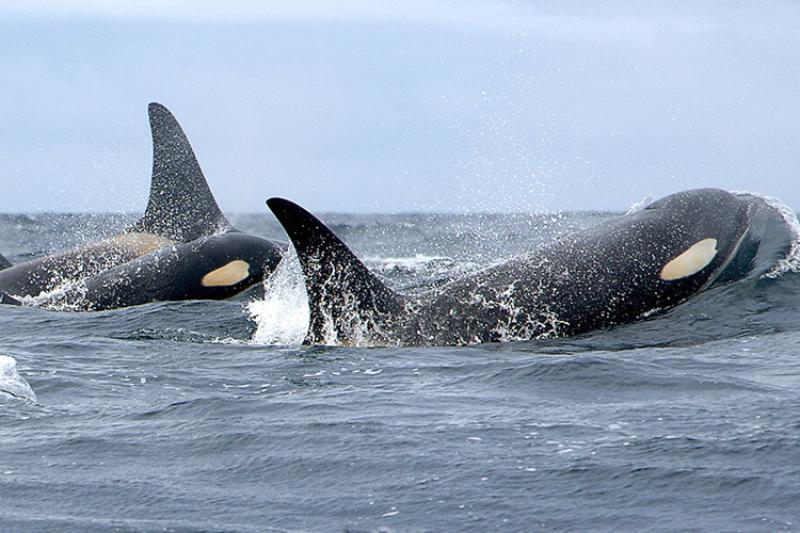Scientists have discovered a new way to estimate the age of endangered Southern Resident killer whales by analyzing DNA from their skin.
Where genetics focuses on changes in the DNA sequence itself, epigenetics explores how DNA is modified or packaged within a cell. For this study, researchers focused on one specific modification of DNA called methylation, which can switch genes on and off.
This approach is more accurate than previous methods and less invasive because it relies on small pieces of skin for samples. This new “epigenetic clock” could also determine the age of killer whales in other populations.
The new research was conducted by NOAA Fisheries Northwest Fisheries Science Center and an international team of scientists. It was recently published in the scientific journal Molecular Ecology Resources.
Analyzing Skin Cells to Estimate Age
Scientists often need to know the age of individual animals to understand their life history and population dynamics (how a population changes over time). However, it is difficult to accurately estimate the age of wild animals, especially long-lived species such as whales.
Traditionally, scientists have used methods such as counting growth rings in teeth or ear plugs to estimate a whale’s age. However, the types of tissues needed for these methods mean that they can only be applied to dead animals.
In recent years, scientists have developed new, minimally invasive methods for estimating the ages of various mammals. One promising approach is to use epigenetic clocks. Epigenetic clocks are based on the idea that DNA methylation patterns predictably change with age. Scientists can create mathematical models to estimate an individual's age by measuring DNA methylation patterns in tissue samples.
Tapping into Wealth of Knowledge of Southern Residents
In this most recent study, researchers tapped into the robust data gathered on Southern Resident killer whales over decades of fieldwork. The many years of documenting the lives of individual Southern Residents and the births of calves have created a uniquely detailed record of many animals in the population.
The researchers also examined samples from Canadian bowhead whales. Bowhead whales are perhaps the longest-lived mammal on the planet. Collaborators from the Department of Fisheries and Oceans Canada contributed skin samples from bowhead whales to the study. This allowed researchers to generate an epigenetic clock that can be applied to both of these very long-lived whales.
The researchers analyzed DNA extracted from small skin samples from both live and dead stranded whales gathered over the past 40 years. They generated data using an approach developed by Steve Horvath at Altos Labs to create an epigenetic clock using age-related differences in skin methylation patterns. The researchers used samples from Southern Resident killer whales whose ages are known to validate the approach. This model, based on methylation patterns, can estimate the age of an individual whale within 2–3 years of their known chronological age.
The researchers believe they can apply this clock to other, less-studied killer and bowhead whale populations. The data collected from this and past studies have shown that killer whales can live 80 or 90 years. While we know a lot about the age structure of the Southern Residents, we don’t know every whale's age. Most killer whale populations are not nearly as well studied as killer whales in the Pacific. Epigenetic clocks can help fill in those gaps.
However, the researchers caution that epigenetic clocks aren’t perfect. “Everyone was excited to know if we were able to use this technique to get an accurate age of J2, often referred to as Granny, one of the oldest matriarchs of the Southern Residents before she died in 2016,” says Dr. Kim Parsons, a molecular geneticist with the Northwest Fisheries Science Center and lead author of the study. “Interestingly, when we analyzed her DNA, we found that her epigenetic age was less than her estimated chronological age.”
Parsons explains that environmental factors like diet, lifestyle, exercise, and stress can impact how mammals, including humans, age. So chronological and epigenetic ages can be different, and your epigenetic age can also vary across different types of tissues in your body. So chronologically, we may be one age, but because of these stressors and other factors, our cells may age faster or slower. “It’s possible Granny won the epigenetic lottery and was an outlier like some humans who live to be over a hundred.”
Understanding Age May Aid Conservation
Overall, the researchers found that the epigenetic clocks are a promising tool for estimating the age of killer and bowhead whales. It’s also less invasive, since we can use a small skin sample that we can collect from living whales.
Accurately estimating the age of individual whales is important for understanding the health of individuals and trends in killer whale populations. Accurately estimating the age of individual whales allows scientists to monitor patterns in age-associated diseases and detect changes in survival and birth rates. These insights can provide an early warning signal for changes in a whale population due to disturbance, disease, and changes in prey.
Next up, the researchers are contributing to a global consortium developing an epigenetic clock that applies to all mammals. Efforts are underway to explore epigenetic data from killer whale populations across the globe. “We’d like to apply this epigenetic clock to killer whale populations in other areas, with different environments and different diets, to help us understand how environmental conditions are affecting how quickly killer whales age in different conditions,” concluded Parsons.;




